Therapeutic Exercise Lab #1 UE Part 1
1/40
Earn XP
Description and Tags
PT631 Therapeutic Exercise I, Oregon Tech
Name | Mastery | Learn | Test | Matching | Spaced |
|---|
No study sessions yet.
41 Terms
ROM Indications for Patients:
Decreases pain, decreases muscle guarding, maintains tissue and joint health, maintains available ROM, and prevents adhesion and contractures.
ROM Indications for Therapists:
Used for demonstration of movement, assessment of joint ROM availability, and assessment of end-feel.
At Glenohumeral Joint, flexion/extension occurs in what plane and axis?
Sagittal, medial-lateral axis.
At Glenohumeral Joint, abduction/adduction occurs in what plane and axis?
Frontal, anterior-posterior axis.
At Glenohumeral Joint, internal/external rotation occurs in what plane and axis?
Transverse, superior-inferior axis.
At Glenohumeral Joint, horizontal abduction/adduction occurs in what plane and axis?
Transverse, superior-inferior axis.
At Scapulothoracic Joint, elevation/depression occurs in what plane and axis?
Frontal, anterior-posterior axis.
At Scapulothoracic Joint, protraction/retraction occurs in what plane and axis?
Transverse, superior-inferior axis.
At Scapulothoracic Joint, upward/downward rotation occurs in what plane and axis?
Frontal, anterior-posterior axis.
At Scapulothoracic Joint, anterior/posterior tilt occurs in what plane and axis?
Sagittal, medial-lateral axis.
At Scapulothoracic Joint, medial/lateral tilt occurs in what plane and axis?
Transverse, superior-inferior axis.
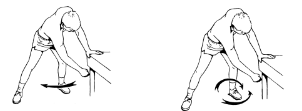
These 2 exercises are testing what?
Self - PROM
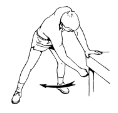
What is this exercise called?
Pendulum Exercise
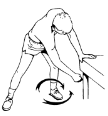
What is this exercise called?
Codman’s Exercise
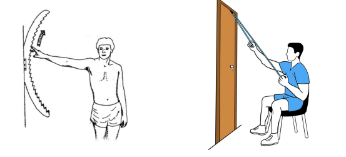
These 2 exercises can test what?
Self - PROM or AAROM
AAROM stands for?
Active Assistive Range of Motion
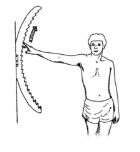
What is this exercise called?
Finger Ladder Exercise
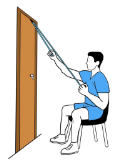
What is this exercise called?
Overhead Pulley Exercise
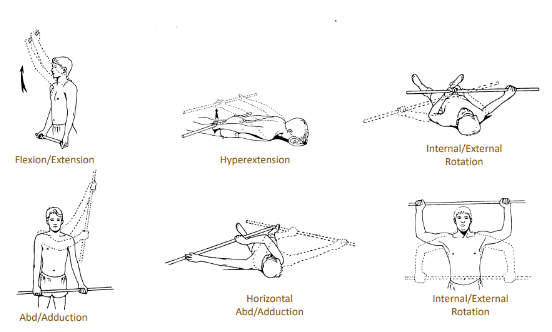
What types of exercises are these?
Wand Exercises
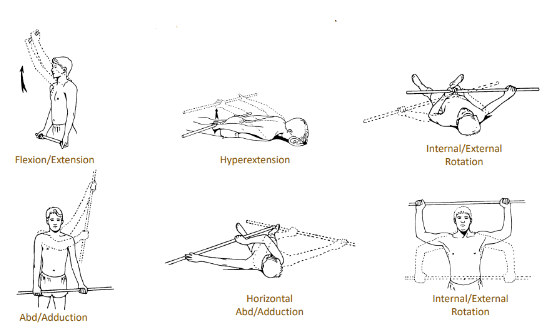
These exercises test for what?
Self - PROM or AAROM
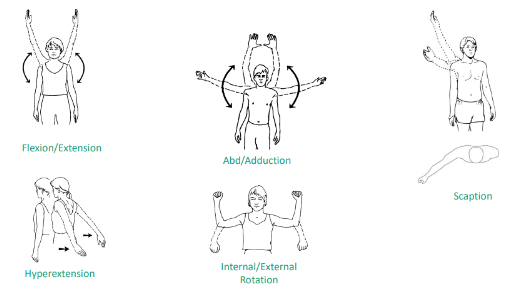
These types of exercises are testing for what?
Self - AROM
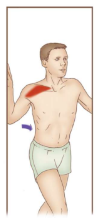
This self-stretch for the right pecs stretches what specifically?
Clavicular Head of Pec Major
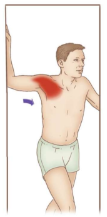
This self-stretch for the right pecs stretches what specifically?
Sternal Head of Pec Major
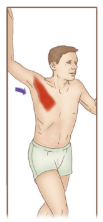
This self-stretch for the right pecs stretches what specifically?
Pec Minor and Costal Head of Pec Major
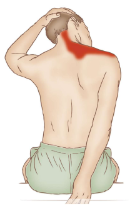
This self-stretch is for?
The Upper Trapezius (Right Side)
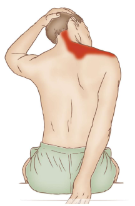
To self-stretch the Right Upper Trapezius, what movements do you need to do?
For the scapula: depression, downward rotation, and protraction. For the neck, flexion, contralateral sidebending, and ipsilateral rotation.
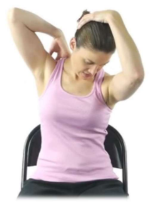
What is this self-stretch used for?
The Levator Scapulae (Right Side)
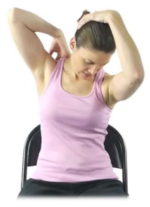
To self-stretch the Right Levator Scapulae, what movements do you need to do?
For the scapula: depression, upward rotation, and protraction. For the neck: flexion, contralateral sidebending, contralateral rotation.
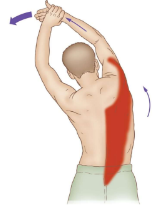
What is this self-stretch used for?
The Right Lats and Teres Major
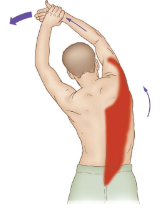
To self-stretch the Right Lats and Teres Major, what movements do you need to do?
For the shoulder: flexion, abduction, and external rotation (palms up). For the trunk: flexion, contralateral sidebending, contralateral rotation.
When are isometric exercises performed?
When initiating a resistive exercise program or when joint movement is prohibited.
What is the order of progression for isometric exercise Rx?
Mid-range → inner range → outer range
When are isometric exercises discontinued?
Once patients are able to perform isometrics in all ranges (mid-inner-outer) of motion they may progress to isotonic exercises (isometrics → isotonics).

This isometric shoulder exercise is called what?
Isometric contraction of the shoulder flexors.

This isometric shoulder exercise is called what?
Isometric contraction of the shoulder extensors.

This isometric shoulder exercise is called what?
Isometric contraction of the shoulder abductors.

This isometric shoulder exercise is called what?
Isometric contraction of the shoulder adductors.

This isometric shoulder exercise is called what?
Isometric contraction of the shoulder internal rotators.

This isometric shoulder exercise is called what?
Isometric contraction of the shoulder external rotators.

This isometric shoulder exercise is called what?
isometric contraction of the shoulder horizontal abductors.

This isometric shoulder exercise is called what?
Isometric contraction of the shoulder horizontal adductors.